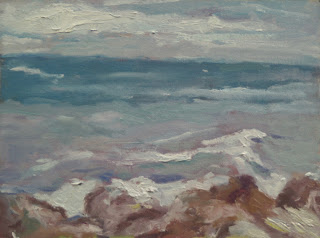A color has three prime characteristics attached to it, which gives its true energy. ‘Tone’ is one of them. ‘Tone’ is a measure of how light or dark a color is, without any consideration for its hue.
But, why does ‘Tone’ carry so much importance in a painting? Well it’s a very important integral part of a color which helps alleviate the painting and also maintains its balance. A painting will be speaking for itself, if it’s tonal values are correct. Each color will be in harmony with other colors surrounding it. It will be like a melodious music composition and not just set of noise ! Value or tonal contrast creates visual interest or excitement in a painting. A high-key painting is one in which the contrasts in value/tone are extreme, from black right through the range of mid-tones down to white. A low-key painting is one in which the tonal range is narrower.
See the illustrative painting below :
A painter needs to be very patient in selecting a colors tone, as it’s very easy to get distracted to the strong appeal of the color and use very drastic and hard contrasts. A painter needs to understand and imagine paintings tones, by subtracting the color and think in its grayscale to get a perfect tonal balance.
But there’s one more important aspect of a tone of a color. It’s that, it’s very much relative to the colors surrounding it. A tone that's obviously light in one context may seem darker in another if it's surrounded by even lighter tones.
Another important aspect is that, its not only relative, but also, the range of tones each color can produce also varies. Yellow is one of the hardest colors to visualize in a tonal range, as even a 'dark' yellow such as cadmium yellow deep seems 'light' when placed next to many other colors. Lighter hues (such as yellows) will produce a smaller range of tones than darker ones (such as blacks). Thus the number or range of tones that can be produced also varies.
With oils or acrylics, the easiest way to lighten a color is to add white. But this is not the only way and not always the ideal as it reduces the intensity of the color. You can also lighten a color by adding another color of a lighter value. Let’s see this with few examples.
- To lighten a dark red, you'll most likely automatically reach for white paint and end up with a range of pinks. Try mixing red with a light yellow instead of only white. Again the variation of the red hue you need also depends on which yellow hue you are using !! :)
- Similarly, the green you get depends on which yellow(s) you mix with which blue(s). To get a lighter tone green, try adding yellow, not white. To get a darker tone green, try adding blue, not black !! :)
So my friends, if you want a light tone, don’t just jump to pick white as a thumb rule, but understand the paintings tonal value and select a color to balance the painting. If the overall painting is dark, a mid-tone may be light enough for the effect you are looking for, else an extremely light tone may be too harsh. The same, of course, applies to darks. If you need a shadow, judge how dark it wants to be by the tones that you've already got in the painting. Don't automatically go for an extreme dark; the contrast may be too great for the overall balance of the photo.
